Delve deep into the heart of the lithium-ion battery manufacturing process. Uncover the secrets behind the power source of tomorrow. With precision, expertise guides each step. The goal is to help you, dear reader, understand this intricate, fascinating process.
Pre-manufacturing Stage!
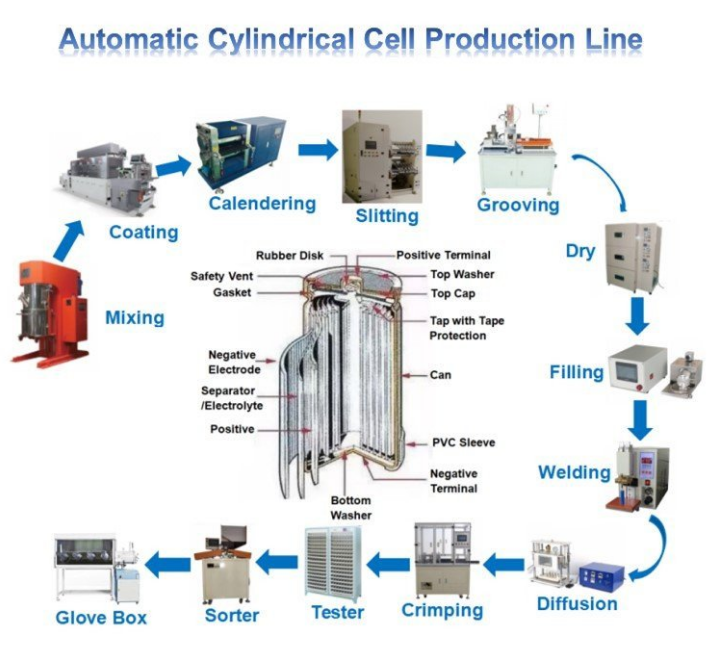
Image Source: etn.news
o Material Sourcing
Material Sourcing starts the lithium ion battery manufacturing process. Key components include lithium, graphite, and metals such as cobalt or nickel. Sourcing high-quality materials ensures battery longevity.
o Raw Material Processing
In Raw Material Processing, all materials get refined. For example, lithium changes into lithium salt, often lithium hexafluorophosphate (LiPF6). Experts deem this phase critical for battery quality.
o Material Analysis
Material Analysis follows, checking purity and structure. High-grade materials will give batteries a longer lifespan. Think of battery performance as a racecar, needing top-tier fuel for top-tier speed.
o Cathode Material
The Cathode Material, typically lithium cobalt oxide (LiCoO2) or lithium iron phosphate (LiFePO4), is chosen next. Each type comes with distinct properties, influencing battery energy, power, and safety.
o Anode Material
The Anode Material, mainly graphite, receives careful selection. The anode stores lithium ions during charging, so quality materials are a must to ensure reliable battery power.
o Binder Preparation
Binder Preparation involves combining polymers to create an adhesive substance. This binder helps the active materials stick to the metal foil in the battery, forming a strong electrode structure.
o Conductive Agent Selection
A suitable Conductive Agent, such as carbon black or graphite, is added to enhance the conductivity of the electrodes. The chosen agent must balance between excellent conductivity and reasonable cost.
o Electrolyte Formulation
Electrolyte Formulation follows, preparing the substance that carries the lithium ions between the anode and cathode. A well-formulated electrolyte, often a lithium salt solution, ensures smooth ion transport, a crucial aspect of battery performance.
o Separator Preparation
The Separator Preparation creates a physical barrier between the anode and cathode. This thin, porous film allows lithium ions to pass through during charging and discharging but prevents short circuits, an essential role in battery safety.
o Casing Material
This step involves choosing the Casing Material. Aluminum and steel are common choices due to their excellent durability and weight considerations. The casing must provide ample protection for the sensitive components inside, another key factor in the lifespan of the lithium battery manufacturing process.
Fabrication of Electrodes!
Introduction to Electrodes in Lithium Ion Batteries
In the heart of the lithium ion battery manufacturing process, electrodes play a crucial role. Two types of electrodes exist: cathode and anode.
The cathode, usually containing lithium metal oxide, is the positive end. In contrast, the anode, housing carbon or graphite, serves as the negative side.
During use, lithium ions move from the anode to the cathode, releasing energy. During charging, these ions shift back to the anode.
Detailed Process of Cathode Fabrication
– Material Mixing
Cathode fabrication begins with the right materials. Mixing lithium metal oxide, binder, and solvent yields a uniform mixture. This step needs accuracy and consistency for a smooth running process.
– Slurry Preparation
Turning the mixture into slurry comes next. A fine, homogenous paste is formed. This paste becomes the base for coating the cathode.
– Coating Process
The prepared slurry gets coated on a thin aluminum foil. The coating process requires utmost precision to avoid any anomalies in the battery.
– Drying Phase
Once coated, the foil moves into the drying stage. High temperatures in special ovens evaporate any remaining solvents. Care is taken to ensure even drying to maintain integrity.
– Calendering Procedure
After drying, calendering or pressing commences. This step increases density and enhances battery performance.
– Cutting Step
Post-calendering, the coated foil is cut into precise sizes. The size depends on the final battery specifications.
– Testing
Each cut electrode undergoes stringent testing. Any faults detected are rectified or discarded. Strict quality control ensures high-performance batteries.
– Packaging
Successful electrodes are then packaged, ready for assembly. Packaging safeguards the components from contamination.
– Storage
Cathodes await assembly in secure, controlled environments. Proper storage is crucial to maintain the quality of the parts.
– Shipment
The cathodes are shipped to assembly plants. Timely delivery is essential to keep the production line running.
Detailed Process of Anode Fabrication
– Material Procurement
Anode fabrication starts with obtaining high-quality graphite or carbon. Good raw materials ensure high battery efficiency.
– Grinding Phase
The raw material undergoes grinding. The goal is to achieve a fine powder for uniform slurry preparation.
– Composite Preparation
The fine powder gets mixed with a binder and solvent. This mixture forms the basis of the anode composite.
– Slurry Making
Turning the composite into slurry follows. A paste-like consistency is achieved, ready for coating.
– Film Coating
Next, the slurry is coated onto copper foil. Like the cathode, careful coating is needed for optimal performance.
– Electrode Drying
The coated foil then enters the drying stage. Any remaining solvents evaporate, leaving behind a solid anode film.
– Calendering
This process involves pressing the dried film. Calendering enhances the density and overall battery function.
– Electrode Slicing
The calendered foil gets sliced into specific sizes. Accurate cutting ensures each anode fits perfectly into the battery design.
– Quality Check
Every anode is subject to rigorous testing. High-quality standards result in batteries with better longevity and safety.
– Storage
Once tested, anodes are safely stored until needed for assembly. The right storage conditions prevent damage and maintain quality.
Quality Control in Electrode Fabrication!
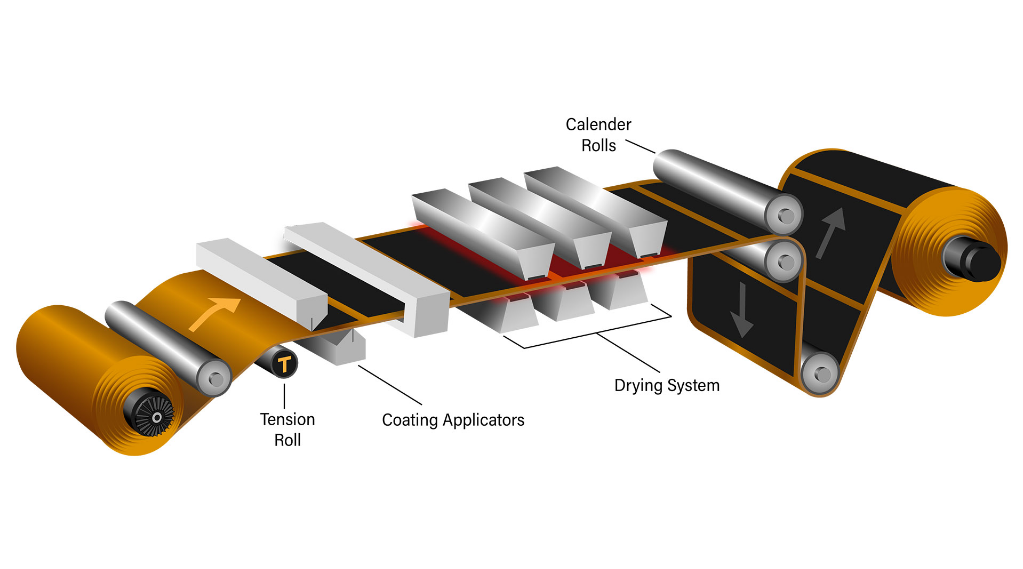
Image Source: dfe.com
Importance of Quality Control in Electrode Fabrication
When discussing lithium battery production, utmost focus should be on quality control. Electrode fabrication forms a significant part of the process. In electrode preparation, material consistency is a key concern. A single deviation in mix quality can disrupt the entire production line. Hence, emphasis is on the integrity of the raw materials and the mix procedure.
Key Methods Employed in Quality Control
– Visual Inspection
Visual inspection forms the primary method of quality control. Here, experts examine electrode plates for deformities. Any small cracks or uneven surfaces get detected. Therefore, constant vigilance is required for successful manufacturing.
– Dimensional Check
Dimensional check ensures precision in electrode size. Every lithium ion battery has specific dimensions. The aim is to maintain uniform size and thickness for better performance.
– Weighing Analysis
Weight plays a vital role in lithium ion batteries. Every battery component must have a specified weight. If the electrodes exceed or fall below this weight, battery performance may get compromised.
– Electrochemical Testing
Electrochemical testing checks the battery’s capacity to hold and transmit energy. Electrode performance is vital in this context. Any defect can lead to battery failure, making testing a must.
– Surface Analysis
Surface analysis allows for a deep look into electrode materials. Here, microscopic examinations reveal any flaws in the material surface. A smooth surface ensures efficient energy transfer.
– SEM Imaging
SEM (Scanning Electron Microscope) imaging gives a detailed view of the electrode surface. With this, any surface flaws become visible. Hence, SEM imaging is essential in quality control.
– XRD Analysis
XRD (X-Ray Diffraction) analysis helps in studying the crystalline structure of electrode materials. The better the crystal structure, the better the battery performance. Therefore, XRD analysis holds significant importance.
– Thermal Analysis
Thermal analysis checks how the electrode materials respond to heat. Overheating is a common issue in batteries. Thus, ensuring that materials can withstand heat is essential.
– Tensile Testing
Tensile testing measures the strength of the electrode material. It helps determine how much stress the material can withstand before breaking. This helps in ensuring durability and longevity of the battery.
– Storage Testing
Storage testing checks how well the battery performs after a period of non-use. Proper storage conditions are vital for battery life. Hence, storage testing is a crucial part of quality control in lithium ion battery manufacturing.
Electrolyte Preparation and Properties!
Role of Electrolytes in Lithium Ion Batteries
– Charge Carrying
In the battery cell manufacturing process, electrolytes transport electrical charge. Between cathode and anode, lithium ions journey through electrolytes. A factor in battery energy density, electrolytes need utmost precision during crafting.
– Ion Conduction
Ion conduction forms the essence of lithium battery performance. Fast ion movement means a more efficient battery. The electrolyte, thus, is a highway for lithium ions, ensuring swift travel and better energy output.
– Stability Provider
Electrolytes act as a balance keeper in a battery. They ensure the ions’ flow isn’t erratic but smooth and consistent. For stable operation, perfect electrolyte constitution is crucial in battery creation.
– Thermal Management
Heat control forms a core part of electrolyte functions. They regulate temperature, minimizing overheating during charging or use. Thus, thermal management holds a critical place in lithium-ion battery production.
– Voltage Determination
An electrolyte’s composition directly influences the battery’s voltage. The higher the electrolyte’s lithium salt concentration, the higher the voltage. Voltage management is thus essential during electrolyte preparation.
– Cycle Life
The life cycle of a battery rests on the electrolyte’s shoulders. With superior electrolytes, batteries can withstand many charge-discharge cycles. Hence, enhancing electrolyte quality can extend the battery’s life span.
– Performance Optimization
Electrolyte properties can tweak battery performance. By adjusting electrolyte parameters, one can increase energy storage, enhance power density, and reduce charging time. Performance optimization forms a significant part of the lithium-ion battery manufacturing process.
– Safety Assurance
Safety is vital in battery production. An electrolyte’s stability can prevent battery failures or explosions. Crafting an electrolyte with safety properties is thus a critical concern during production.
– Shelf Life
Electrolytes influence the battery’s shelf life. High-quality electrolytes can extend battery storage time before use. Ensuring the right electrolyte mixture can, therefore, enhance the battery’s shelf life.
– Internal Resistance
Electrolytes also govern a battery’s internal resistance. Lower resistance means efficient energy flow, translating to better performance. By adjusting the electrolyte properties, one can manage the battery’s internal resistance.
Process of Electrolyte Preparation
– Solvent Selection
To begin the lithium-ion battery manufacturing process, an apt solvent selection is crucial. Organic solvents like EC, DMC, and DEC can be ideal choices. The solvent must exhibit high dielectric constants to promote Li-ion dissociation.
– Salt Dissolution
Following solvent selection, the salt dissolution phase commences. Generally, LiPF6 is the most commonly used lithium salt due to its superior ionic conductivity. Salt is gradually mixed into the solvent for complete dissolution.
– Additive Addition
After salt dissolution, additive incorporation follows. Additives like VC and FEC improve battery lifespan and safety. The careful integration of additives can significantly enhance battery performance.
– Mixture Stirring
Now, the stirring of the electrolyte mixture happens. For homogenization, the mixture is stirred at a temperature between 50-60°C. Uniform stirring promotes the even distribution of all constituents.
– De-aeration Process
In the de-aeration process, the electrolyte is subject to a vacuum. Vacuum application removes any entrapped air bubbles from the mixture, ensuring high electrolyte purity.
– Filtration
Next, filtration happens to eliminate any unwanted particulates. The electrolyte undergoes microfiltration under clean room conditions. This process warrants a particulate-free electrolyte for better performance.
– Quality Control
QC in the lithium-ion battery assembly process holds immense value. Electrolyte quality is assessed via testing parameters such as ionic conductivity, moisture content, and appearance to ensure top-notch results.
– Storage
After quality checks, the electrolyte requires safe storage. Storage conditions must be cool, dry, and free from dust and moisture to preserve electrolyte quality and extend shelf life.
– Dispensing
Post-storage, electrolyte dispensing takes place. The electrolyte is transferred to the battery cell with precision, avoiding any possible spills or leaks during this sensitive step.
– Use in Assembly
The usage of the electrolyte in the battery assembly is most important. The electrolyte is injected into the cell, and the battery is then sealed, marking the culmination of the electrolyte preparation process.
Cell Assembly!
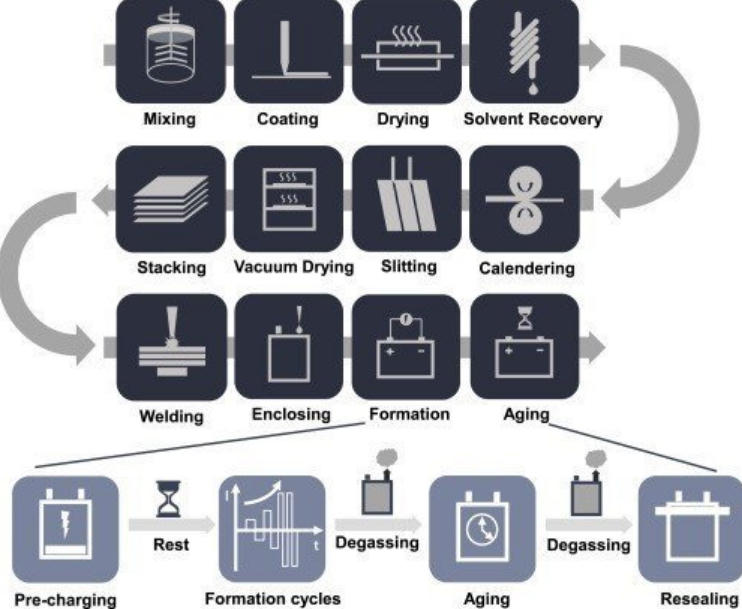
Image Source: etn.news
Different Types of Cell Structures
– Cylindrical Cells
Cylindrical cells make a strong option for a lithium battery assembly. There, thin layers of active materials roll around a central core. By doing that, large energy amounts can be packed into a compact space. To seal the power, the cylinder gets capped at each end.
– Prismatic Cells
Prismatic cells bring unique benefits to the lithium battery assembly. These batteries have a flat, rectangular shape. Their design lets them fit perfectly in slim devices like tablets. Yet, their energy output can compete with bigger, bulkier options.
– Pouch Cells
Let’s turn the spotlight on pouch cells now. These flexible, light, and thin batteries have a huge energy density. The shape is flat like a packet of ketchup. That makes them great for small electronic devices. But their construction is quite complex.
– Button Cells
In the lithium battery manufacturing process, button cells hold an important role. They are small, flat, and round batteries. Used often in tiny devices like hearing aids and watches, their compact size can house great power.
– Stacked Cells
Looking at stacked cells, one can see their unique design. Multiple layers of electrodes stack on top of each other. This creates a sandwich-like structure. Stacked cells can store a lot of power in a tiny space.
– Spiral Cells
Spiral cells have a unique design. They have layers of electrode material wound tightly around a central core. This allows them to store more energy than conventional batteries. Plus, their cylindrical shape makes them versatile for many applications.
– Bipolar Cells
Bipolar cells have their electrodes back-to-back. They are unique in the lithium battery manufacturing process. This design can cut down on internal resistance. As a result, these cells can provide high power output.
– Modular Cells
Modular cells are worth noting too. They are small batteries that can join to form bigger battery packs. This makes them highly adaptable and versatile. With these, the power output can be adjusted to meet specific needs.
– Packaged Cells
Packaged cells work well for many devices. They house several smaller batteries within a single unit. That boosts the energy output. With packaged cells, one can get great power from a compact structure.
– Solid-State Cells
Solid-state cells are pushing battery tech forward. These batteries replace liquid electrolytes with solid ones. This can boost energy density, lifespan, and safety. This design could be the future of battery technology.
Procedure for Cell Assembly
– Electrode Stacking
In the lithium battery assembly, electrode stacking is vital. Stacking occurs in a well-maintained environment to avoid contamination. Cathodes, anodes, and separators are aligned and stacked systematically. This organization ensures a precise structure and superior battery performance.
– Cell Compression
Once the stack of electrodes is assembled, the cell undergoes compression. This step maintains the desired thickness. It also enhances the internal resistance of the battery. Correctly performed compression guarantees a reliable and efficient battery.
– Can Insertion
Next comes can insertion. The compressed cell assembly is placed into a can, often cylindrical or prismatic. This can serves as a physical protective layer. It also supports electrical connections and facilitates heat dissipation.
– Electrolyte Filling
Then, electrolyte fills the can. Electrolytes are compounds that conduct electricity by ion movement. In a lithium-ion battery, organic liquid electrolytes are common. They enable ion flow between the anode and the cathode.
– Sealing Process
Post electrolyte filling, the can undergoes sealing. Sealing prevents leakage and contamination. An effective seal maintains the internal environment and battery function over time.
– Formation
The newly assembled battery moves to formation. Here, charging and discharging occur for the first time. This step activates the battery and forms the SEI layer. It’s crucial for long-term battery performance.
– Aging Stage
Post-formation, the batteries enter the aging stage. Here, they rest for several days at specified temperatures. Aging enhances the stability of the SEI layer, influencing battery efficiency and lifespan.
– Inspection
Inspection of batteries happens next. Visual and electrical tests are common. Faults, leaks, or abnormal behaviors are noted. Only batteries that pass these rigorous tests proceed further.
– Labeling
Each battery receives a label after inspection. Labels contain crucial data like voltage, capacity, batch number, and more. Accurate labeling helps track battery performance and identify issues in production.
– Packaging
Batteries are carefully packed to avoid damage during transport. Good packaging preserves the integrity of the battery until it reaches the end user. This final step concludes the lithium-ion battery manufacturing process.
Electrode Stacking and Winding!
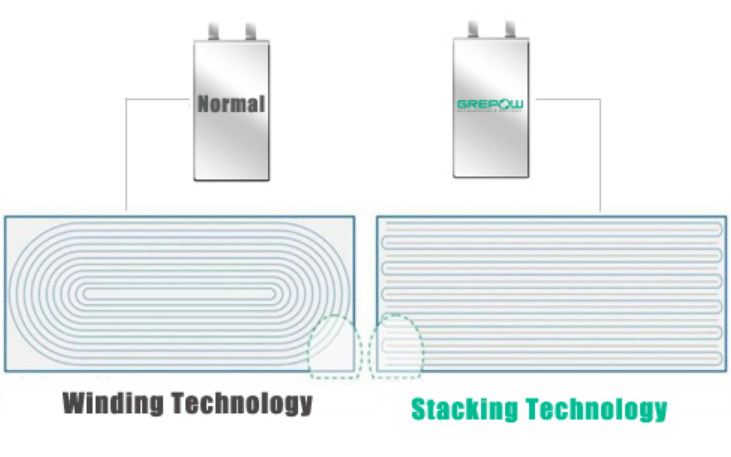
Image Source: www.grepow.com
Importance of Electrode Stacking and Winding
During the Lithium ion battery manufacturing process, precision in electrode stacking and winding is key. Picture a symphony; every musician contributes. Likewise, each electrode layer impacts battery performance. Too thin, the energy capacity decreases.
If too thick, energy transfer suffers. Precise stacking boosts efficiency, leads to durable batteries with optimal capacity. This meticulous process is non-negotiable for maintaining high product standards.
Procedure for Electrode Stacking
– Electrode Sorting
Every battery starts with sorting electrodes. Think of the alphabet; A comes before B. The same goes for positive (cathode) and negative (anode) electrodes. Cathode comes first then the separator and finally anode. Each piece must be in the correct order.
– Alignment
Once sorted, electrodes align perfectly like placing dominoes in a row. Precision is paramount. Accurate alignment ensures optimal energy flow within the battery, much like traffic on a well-planned road.
– Layering
After alignment comes layering. Layering electrodes is akin to folding paper – one on top of the other. Each fold, or layer, is crucial. Too few, the battery’s capacity drop. Too many, the energy flow stumbles.
– Compression
Next is compression. You just picture squishing a sandwich into a lunch box. Electrodes compress into a compact, cylindrical cell. The aim is to achieve optimal energy density. Precision is paramount to avoid cell damage.
– Inspection
Post-compression, every cell undergoes a thorough inspection. Consider a teacher grading papers. Every mark counts. The same goes for cells. Any defect, however small, is unacceptable. Only flawless cells pass.
– Storage
Inspected cells move into storage like placing apples in a barrel. Careful storage preserves cell quality, ensuring they’re ready for the next step in the cylindrical cell manufacturing journey.
– Transport
Next, cells transport to assembly lines. Consider a conveyor belt at the grocery store for moving products smoothly from one place to another. Similarly, proper transport preserves cell quality, readies them for assembly.
– Stacking Equipment
Stacking requires specialized equipment. Think of a baker using a mixer. The right tools ensure consistent, high-quality results. In stacking, machinery accuracy is vital for optimal cell performance.
– Work Safety
Safety is always a priority. Imagine a construction site. Hard hats, safety boots are essential. The same applies to battery manufacturing. Proper safety measures ensure a secure work environment.
– Quality Check
Every battery is tested. Picture a chef tasting soup before serving. Perfecting the recipe guarantees customer satisfaction. Similarly, quality checks ensure reliable, high-performing batteries reach the market.
Procedure for Winding
– Electrode Unwinding
In the initial stage, one must unwind the electrode roll, loaded with Lithium ions. With precision, unroll both the positive and negative electrodes. Stable speed control is vital. Watch out for any wrinkles or distortions.
– Tension Control
Next, maintain tension. It’s an essential parameter. With a consistent force, the electrode roll unwinds smoothly. Tension control mitigates issues like electrode displacement or winding core deformation.
– Winding
Afterwards, the winding process starts. With extreme care, intertwine the positive and negative electrodes. Use separators to prevent electrical contact. A well-wound core ensures optimal battery performance.
– Compression
Following winding, apply force for compression. A specialized device applies pressure uniformly. Proper compression aids in achieving the desired thickness. Too much pressure might damage the layers, though.
– Inspection
Post-compression, inspection is crucial. Special equipment checks for any inconsistencies. Size, alignment, and winding quality all come under scrutiny.
– Jelly Roll Formation
Subsequently, a ‘jelly roll’ forms. It’s a tight, spiral wound structure of interleaved electrodes. Accurate winding guarantees uniformity in jelly roll formation.
– Quality Check
In the penultimate stage, there’s a thorough quality check. Every single jelly roll undergoes an inspection. Flaw detection at this stage prevents future battery failure.
– Handling
Proper handling is a must during the entire process. Any mishap can lead to defective batteries. Always use clean gloves and follow safety protocols.
– Storage
After quality checks, the jelly rolls go into storage. Store them in a dry, cool place. Proper storage conditions enhance shelf life.
– Winding Equipment
Never underestimate the importance of winding equipment. Modern machinery ensures precision and high-speed operation. Equipment maintenance guarantees long-term, smooth production.
| Process Steps | Electrode Unwinding | Tension Control | Winding | Compression | Inspection | Jelly Roll Formation | Quality Check |
| Objective | Prepares electrodes | Ensures smooth unwind | Layers the components | Improves energy density | Detects defects | Creates compact structure | Verifies adherence to standards |
| Parameters | Feed rate, Diameter | Force (N), Speed (m/s) | Speed (rpm), Overlap % | Pressure (psi), Time (s) | Imaging, Measurement | Diameter, Layer count | Measurements, Acceptance criteria |
| Equipment | Unwinding machine | Brake system | Winding machine | Hydraulic press | Vision system | Winding machine | Automated test equipment |
| Key Factors | Electrode integrity, Speed | Force uniformity, Electrode alignment | Precision, Layer alignment | Consistency, Pressure uniformity | Detection rate, Accuracy | Roll tightness, Uniformity | Test coverage, Pass/fail rate |
| Output | Unwound electrodes | Properly tensioned electrode | Wound cell | Compressed cell | Inspection report | Jelly roll | Quality report |
| Potential Issues | Tearing, Misalignment | Over/under tension, Misalignment | Incomplete wind, Misalignment | Over/under compression, Inhomogeneity | False positives/negatives | Loose/tight roll, Layer shift | False pass/fail, Inaccurate measurements |
| Risk Mitigation | Gentle handling, Proper feed rate | Proper brake setting, Regular checks | Accurate machine settings, Training | Correct pressure, Even distribution | Calibration, Double checks | Precise settings, Slow winding | Regular calibration, Double checks |
Table on Procedure for Winding!
Separator Roles and Placement!
Understanding the Role of Separators
– Ion Conduction
In lithium-ion battery manufacturing process, the separator serves an essential role. Acting like a highway, it allows lithium ions to move freely between the cathode and the anode. Smooth and efficient ion conduction assures the battery performs well. Remember, the better the ion flow, the more power the battery can generate.
– Safety Feature
Safety is a key concern in any manufacturing process. Separators add a layer of security. During operation, they prevent the anode and cathode from coming into contact. A mishap here could cause short-circuits, leading to damage or, in worst cases, combustion. Hence, separators uphold safety standards.
– Thermal Stability
Stability under heat is crucial for a battery’s performance. In case of temperature spikes, the separator must maintain structure and function. Thermal instability could lead to serious safety hazards. So, separators contribute to a battery’s resilience, allowing it to withstand high temperatures.
– Chemical Inertia
The separator must resist chemical reactions. This characteristic, known as chemical inertia, prevents unwanted reactions that could harm battery performance. A chemically inert separator ensures battery longevity and optimal function.
– Mechanical Strength
The separator must exhibit strength to withstand mechanical stress. This can come from assembly, installation, or use of the battery. High mechanical strength is crucial for a separator to perform well under various conditions.
– Electrolyte Wettability
In a battery, the separator must be compatible with the electrolyte. The electrolyte must ‘wet’ or cover the separator evenly. This allows smooth ion conduction. Without proper wettability, the battery might fail to deliver expected performance.
– Dimensional Stability
A separator’s size and shape must remain constant under various conditions. This quality, known as dimensional stability, prevents issues like warping or shrinking. Maintaining dimensional stability ensures the battery’s structural integrity.
– Pore Structure
Pore structure in a separator impacts a battery’s performance. The right size and number of pores allow for optimal ion flow. Too few or too small pores could hinder performance, while too many or too large could compromise safety.
– Thickness
Separator thickness matters. If too thin, it might fail to prevent a short circuit. But, if too thick, it could obstruct ion flow. Manufacturers must strike a balance, ensuring thickness neither compromises neither safety nor performance.
– Manufacturing Consideration
Understanding separator roles helps optimize the battery assembly process. Factors like ion conduction, safety, thermal and dimensional stability, mechanical strength, wettability, pore structure, and thickness matter. Balancing these aspects ensures the production of high-performing and safe lithium-ion batteries.
Process of Separator Placement
– Selection
A key phase in the battery assembly process is picking a separator. High-quality polyethylene (PE) or polypropylene (PP) options excel. Withstanding temperatures of 130°C to 140°C, PE displays exceptional melt integrity. Meanwhile, PP resists shrinkage up to 160°C. Therefore, your choice should reflect battery requirements.
– Handling
Precision is crucial when managing separators. To prevent damage, dust-free environments are preferred. Special handling equipment, using delicate grips, helps maintain separator integrity. Stringent protocols ensure no tears, crimps, or wrinkles occur.
– Alignment
Accurate alignment guarantees optimal battery performance. A slight misplacement can lead to short circuits. Aligners with advanced visual systems ensure separators sit accurately. Regular calibration of these machines helps achieve micron-level precision.
– Placement
During placement, the separator unrolls onto anode and cathode layers. The machine’s adjustable speed setting helps to maintain a steady pace. Regular inspections ensure the proper alignment and flatness of separators.
– Verification
Post-placement verification affirms separators’ correct positioning. State-of-the-art optical inspection systems scan for abnormalities. With accuracies reaching 0.001mm, these systems can spot the slightest misalignments.
– Adjustment
When discrepancies surface during verification, prompt adjustments occur. Advanced correction mechanisms refine separator positioning, maximizing battery safety. Every fine-tuning step reinforces reliability.
– Compression
Following adjustments, separator layers undergo compression. This process reduces overall battery thickness. Employing hydraulic or pneumatic presses, manufacturers achieve pressures up to 100 MPA.
– Storage
Safeguarding separators post-production is paramount. Stored in low humidity, temperature-controlled areas, separators remain undamaged. Proper labeling ensures quick retrieval, optimizing production flow.
– Inspection
Regular inspections certify storage conditions. Using precise humidity and temperature sensors, operators maintain optimal environments. Such diligence prolongs separator quality, ensuring successful battery assembly.
– Quality Control
Rigorous quality control solidifies trust in the production process. Every step, from selection to storage, undergoes scrutiny. With uncompromising standards, manufacturers deliver high-performing, safe lithium-ion batteries.
Case and Can Production!
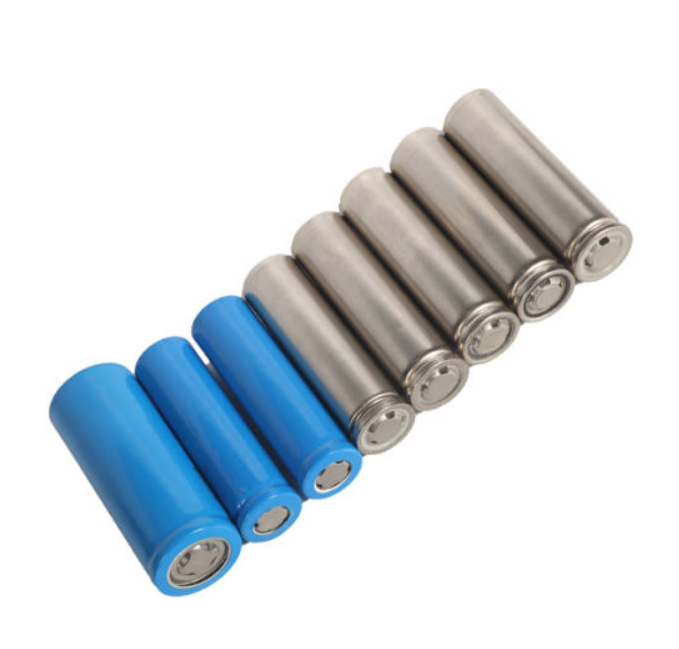
Image Source: gelonlib
Importance of Case and Can
Understanding the value of case and can in the lithium-ion battery manufacturing process is vital. Cases serve as the battery’s main body, securing all internal parts. They provide structural integrity, safeguarding against physical impact.
Cans, on the other hand, are the exterior layer, shielding the battery from environmental factors. They prevent moisture and dust intrusion, ensuring long battery life. Hence, the robustness of cases and cans directly influences battery durability and performance.
The Manufacturing Process of Case and Can
– Material Selection
The choice of material for cases and cans is crucial. Typically, aluminum or steel is preferred due to their strong, lightweight, and corrosion-resistant nature. These materials withstand harsh conditions, ensuring battery safety.
Moreover, their thermal conductivity helps in heat dissipation, thus controlling the battery temperature.
– Die-Casting
In the die-casting stage, molten metal is forced into a mold cavity under high pressure. It solidifies quickly to form the rough shape of the case or can. Die-casting ensures consistent dimensions and uniformity across all parts, which are key for battery assembly.
– Precision Machining
Next comes precision machining. It refines the rough die-cast parts into accurate shapes. Using advanced machines, manufacturers achieve extreme accuracy, down to a few micrometers. It ensures tight fits for all battery components, an essential aspect of battery integrity.
– Cleaning
Cleaning follows precision machining. Manufacturers use ultrasonic cleaners to remove dust, oil, and other residues from the machined parts. Clean parts prevent contamination in subsequent stages, guaranteeing the quality of the end product.
– Inspection
Inspection comes next in line. Each case and can undergo rigorous quality checks. Manufacturers use visual and mechanical tests to identify defects. Any parts that don’t meet the set standards are rejected, ensuring only the best reach the next stages.
– Surface Treatment
The parts then undergo surface treatment. The process often involves coating the metal surfaces to resist corrosion and improve electrical conductivity. It enhances the durability and efficiency of the finished batteries.
– Marking
Marking is the next step, where manufacturers imprint information like brand name, batch number, and manufacturing date onto the cases and cans. It provides traceability and helps in quality control during and after production.
– Packaging
Next, the cases and cans are packed for storage. Manufacturers use anti-static materials for packing to prevent any electrical charges from damaging the parts. Correct packaging preserves the quality of the parts until assembly.
– Storage
Proper storage is essential to maintain the parts’ quality. Manufacturers store the packed parts in dry, dust-free conditions. Careful storage prevents any possible damage or contamination, keeping the parts ready for assembly.
– Shipment
Manufacturers ship the cases and cans to the assembly plant. They ensure safe transportation to avoid any damage during transit. Once at the assembly plant, the parts enter the lithium ion battery pack assembly process, marking the start of the next manufacturing phase.
Cell Insertion!
Overview of Cell Insertion
The lithium battery process starts with cell insertion. Here, a small can holds the cell materials. Then, the cells are put inside these cans. All the cells should be in the right place and in the right way. Lastly, a machine checks if the cells are good and ready. Now, we’re ready for the next step.
The Detailed Process of Cell Insertion
– Cell Inspection
First, experts inspect the cells. They check if the cells are good and ready for use. This inspection helps make sure the batteries will work right.
– Can Positioning
Next, the cans are set up. The machine puts them in the right place for the cells. All cans need to be just right for the cells.
– Insertion
After that, the cells go into the cans. A machine does this. It makes sure all cells are in right and safe.
– Alignment Check
Now, another machine checks the cells. They must be in the cans right. This is to make sure the batteries will work well.
– Compression
Then, the machine presses down on the cells. This is to make sure they fit well in the cans. It’s important for the cells to stay in place.
– Seal Verification
After that, a machine checks the seals. The seals must be tight and strong. This keeps the cells safe and the batteries working.
– Quality Control
Now, experts check everything again. They make sure the cells, cans, and seals are all good. This makes sure the batteries are top quality.
– Transport
Next, the cells are moved. They go to a safe place to wait. They wait for the next step in making batteries.
– Storage
The cells stay safe while waiting. They’re in a special place that keeps them good. This is important for the cells to stay good.
– Further Processing
The cells move on. They’re ready for the next step. They’re on the way to becoming a battery.
Electrolyte Filling!
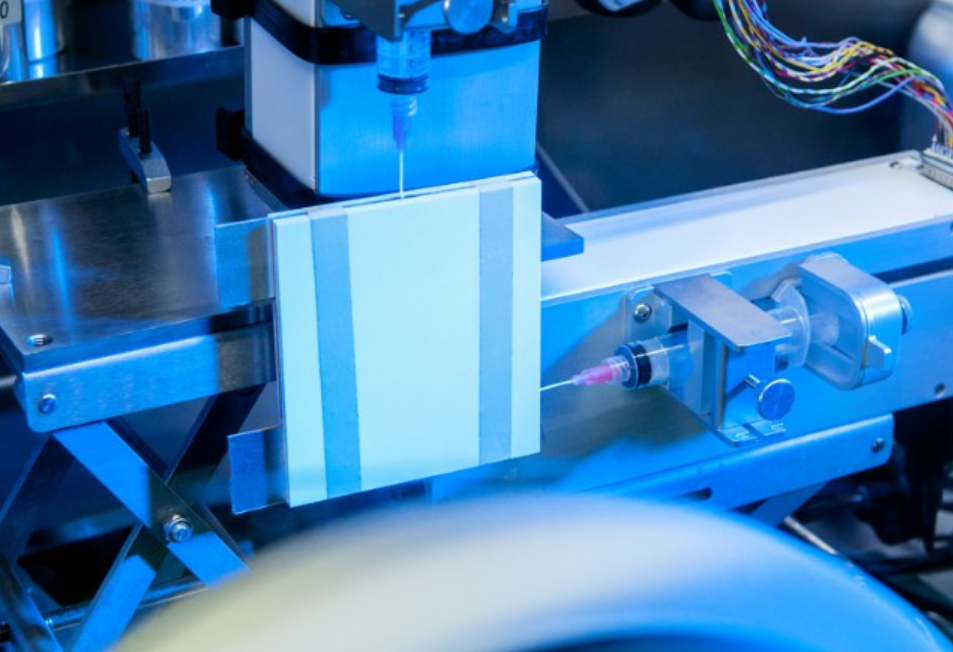
Image Source: www.ikts.fraunhofer.de
The Significance of Electrolyte Filling
The next big step is filling with electrolyte. The electrolyte makes the battery work. It’s a liquid that lets electricity move between the cells. All the cells need to be filled just right. This makes sure the batteries will work well and last a long time.
Procedure for Electrolyte Filling
– Preparation
First, the cells and electrolyte are set up. The machine and experts are ready. Now, they can start filling the cells.
– Dispensing
Next, the machine starts. It gives out the right amount of electrolyte. All the cells get the same amount.
– Filling
Then, the machine puts the electrolyte into the cells. It’s important that all the cells get filled right. This helps the battery work well.
– Weight Verification
Now, a machine checks the weight. Each cell needs to be the right weight. This makes sure the right amount of electrolyte is in each cell.
– Leakage Check
After that, a machine checks for leaks. The cells can’t leak. That would make the batteries not work right.
– Seal Inspection
Then, a machine checks the seals again. The seals need to be tight and strong. This keeps the electrolyte in and helps the battery work.
– Quality Control
Now, experts check everything again. They make sure the cells, electrolyte, and seals are all good. This makes sure the batteries are top quality.
– Storage
The cells stay safe while waiting again. They’re in a special place that keeps them good. This is important for the cells to stay good.
– Transport
Next, the cells are moved. They go to a safe place to wait. They wait for the next step in making batteries.
– Cell Sealing
The cells are sealed up. They’re safe and ready to go. They’re on the way to becoming a battery.
Cell Sealing!
Importance of Cell Sealing
In the Lithium-ion battery manufacturing process, cell sealing stands paramount. An effective seal safeguards against leakages, preserving battery life. Precise sealing results in reliable batteries, vital in various applications, like electric cars, laptops, and mobile phones.
Procedure for Cell Sealing
– Preparation
Before sealing, the battery’s case, cap, and sealing gasket undergo thorough cleaning. This eradicates unwanted particles, guaranteeing a secure seal.
– Alignment
Following this, correct alignment of the case and cap becomes critical. Misalignment can lead to sealing failures, negatively impacting battery performance.
– Sealing Process
Now, the cap is sealed onto the case. High pressure, typically 100-200 kg/cm², with a hold time of 10-20 seconds, ensure an effective seal.
– Inspection
Post-sealing, a visual check confirms the seal’s integrity. Any visible defects call for immediate rejection.
– Leak Testing
Next, helium leak testing occurs. A leak rate lower than 5×10⁻⁶ mbar.l/s indicates a good seal.
– Weight Verification
An accurate check on battery weight confirms the absence of any missing components.
– Marking
After weight verification, unique identification markings get etched on the battery. This eases tracking and future reference.
– Storage
Batteries are then stored in a humidity-controlled environment to maintain their optimal condition.
– Quality Control
At regular intervals, quality checks are carried out. These ensure consistency in the sealing process.
– Packaging
Sealed batteries are packed carefully, ready for the next stage in the manufacturing process.
Formation and Aging!
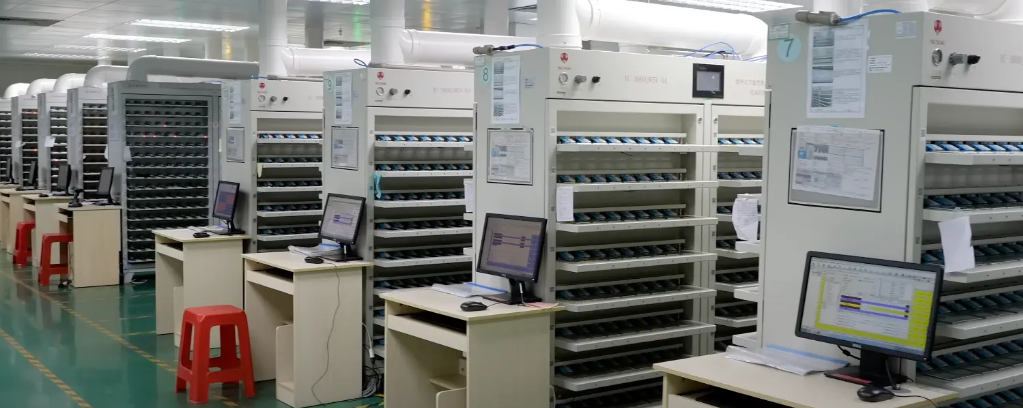
Image Source: www.lipolbattery.com
Understanding Formation and Aging
Formation and aging are equally crucial stages in the lithium-ion battery manufacturing process. During formation, the battery undergoes initial charge/discharge cycles. Aging, on the other hand, determines the battery’s service life and overall performance.
The Procedure for Formation and Aging
– Cell Charging
Formation begins with initial cell charging at a controlled rate. Slow charging enhances battery efficiency.
– Discharging
Post-charging, the cell discharges at a fixed rate. Discharging forms the SEI (Solid Electrolyte Interphase), a critical step.
– Resting Phase
A resting phase follows each charge/discharge cycle, stabilizing the cell’s chemical state.
– Cycling
The charging, discharging, and resting process is repeated multiple times, usually 3-5 cycles.
– Inspection
After cycling, a thorough inspection checks for abnormalities.
– Aging Time
Cells are then left to age. Aging time may range from hours to weeks.
– Temperature Control
Throughout aging, temperature remains controlled. This prevents thermal damage.
– Capacity Measurement
Post-aging, battery capacity gets measured. This helps identify potential defects.
– Voltage Verification
A final voltage check confirms the battery’s ability to hold charge.
– Quality Control
As the last step, meticulous quality control checks ensure the readiness of the battery for market deployment.
Electrical Testing and Quality Assurance!
Importance of Electrical Testing
In the lithium ion battery manufacturing process, electrical testing holds a key position. Here, each battery undergoes rigorous checks. Every measure ensures high performance.
Standards define the test criteria. Battery specifications, such as voltage, current, and capacity, get confirmed. Tests expose faults, if any, early in the process. Every faulty unit gets removed. Thus, only the best batteries move ahead. Quality assurance, hence, becomes critical.
Reliable products lead to satisfied customers. High product quality means less waste. It improves process efficiency, too. So, the entire cycle benefits from strict electrical testing.
Detailed Procedure for Electrical Testing
– Cell Mounting
In cell mounting, cells get arranged in a specific order. This setup defines the battery’s voltage and capacity. Cell mounting also ensures effective heat dissipation.
– Connection Verification
Next, each cell connection gets verified. Solid connections are critical for proper battery function. A loose link can result in battery failure.
– Load Testing
Load testing confirms the battery’s ability to handle specific loads. It helps ascertain if the battery can meet power demands.
– Capacity Measurement
Here, the exact amount of electric charge a battery can deliver is measured. A battery’s capacity directly affects its performance and lifespan.
– Impedance Check
Impedance check identifies the resistance to current flow. Lower impedance means a healthier battery.
– Overcharge Testing
Overcharge testing evaluates the battery’s response to excessive charging. A good battery must prevent overcharging to avoid damage.
– Short-Circuit Test
This test checks the battery’s safety features. It ensures the battery doesn’t catch fire or explode when short-circuited.
– Thermal Runaway Check
In thermal runaway check, batteries are pushed to their thermal limits. They must safely shut down and not overheat or catch fire.
– Data Recording
All test results get recorded. This data serves as a reference for future improvements.
Battery Pack Assembly!
Role and Design of a Battery Pack
– Energy Storage
A battery pack stores energy. Its design impacts energy storage capacity. Higher capacity leads to longer run times.
– Power Delivery
The battery pack must deliver power efficiently. Efficient power delivery means longer battery life and less energy waste.
– Safety
Safety is a vital design consideration. Battery packs need in-built safety mechanisms. These features protect against overcharge, over-discharge, and short-circuit scenarios.
– Thermal Management
Proper thermal management prevents overheating. It also extends the battery life.
– Connectivity
The design should ensure easy connection to devices. Poor connectivity can lead to power loss and inefficiency.
– Modularity
Modularity allows easy replacement or upgrade of individual cells. This feature improves the lifespan and usability of the battery pack.
– Monitoring System
A battery pack requires a monitoring system. This system tracks the battery’s health and performance.
– User Interface
User-friendly designs help users understand battery status. Clear indicators for charging and discharging are necessary.
– Pack Enclosure
Pack enclosures protect the cells. Materials used should be durable and resistant to environmental factors.
– Material Selection
The choice of materials affects battery weight, cost, and performance.
Procedure for Battery Pack Assembly
– Cell Positioning
First, the cells are positioned in the pack. Their arrangement determines the pack’s voltage and capacity.
– Connection Soldering
Then, the cells are connected. These connections are soldered to ensure stable power delivery.
– BMS Installation
Next, a Battery Management System (BMS) is installed. BMS oversees battery operations. It maintains safety and efficiency.
– Thermal Management Setup
Thermal management components are set up. These help keep the battery cool.
– Enclosure Fitting
The cells, now connected and managed, get enclosed. The enclosure provides physical protection.
– Seal Verification
Seals get checked for any leaks. A tight seal ensures long battery life.
– Functionality Check
Next, the assembled pack is tested. The pack’s functions, as a whole, are checked.
– Safety Testing
Safety tests ensure that the pack can handle stress scenarios.
– Labeling
Labels providing important information are affixed. The battery pack is now ready for use.
Final Inspection and Packaging!
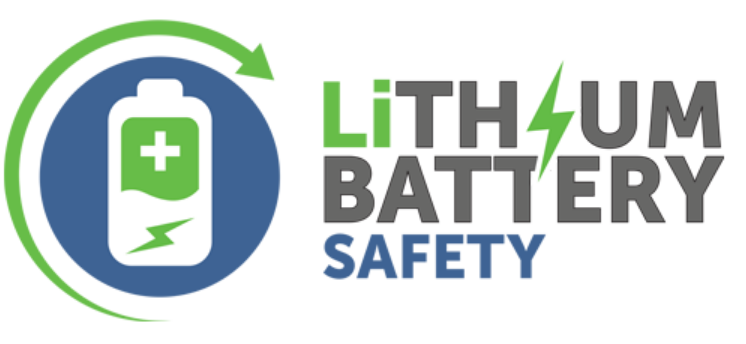
Image Source: www.phmsa.dot.gov
Significance of Final Inspection
Inspection marks a critical phase in Lithium ion battery manufacturing process. Batteries undergo scrutiny to ensure top-notch quality. Each cell gets examined for defects.
Early detection of flaws mitigates costly losses. Inspection promotes confidence in the end product, boosting customer satisfaction. Hence, final checks solidify a battery’s reliability before shipping.
Procedure for Final Inspection and Packaging
– Visual Inspection
Each battery undergoes a careful look-over. Trained eyes detect surface abnormalities, discolorations, or deformations. Even minor defects get noted for superior quality assurance.
– Weight Check
Batteries pass through a rigorous weighing procedure. Any deviation from the standard weight could indicate manufacturing issues. Precision scales guarantee accurate results.
– Size Verification
Dimensional checks follow. Tools measure length, width, and height, confirming compliance with design specifications.
– Electrical Test
Each battery’s electrical performance gets assessed. Tests include voltage, capacity, and internal resistance checks. Faulty batteries are discarded; ensuring only good products reach customers.
– Packaging Selection
The right packaging is crucial for safe delivery. Material choice depends on the battery size, shape, and transportation method.
– Label Application
Labels with critical information such as model, voltage, capacity, and manufacturing date are applied. This offers users essential details about the battery.
– Packaging
Batteries are carefully placed into selected packaging. Adequate cushioning prevents any damage during transit.
– Sealing
Packaging gets sealed securely. Strong adhesives are used, ensuring no tampering occurs.
– Storage
Packed batteries get stored under specific conditions, ready for shipping.
– Shipment
Batteries finally head out for delivery, reaching consumers in perfect condition.
Warehousing and Transportation!
Proper Storing of Lithium Ion Batteries
– Temperature Control
Batteries need a controlled climate. Excessive heat or cold can affect their performance. Thus, temperature control systems are mandatory.
– Humidity Management
High humidity can lead to corrosion. Warehouses use dehumidifiers to maintain a safe level.
– Avoid Sunlight
Direct sunlight can heat batteries, leading to performance loss. Warehouses design for minimum sunlight exposure.
– Stack Limitations
Over-stacking can damage batteries. Warehouses set stack limitations, preventing unnecessary pressure.
– Fire Protection
Safety measures such as fire alarm systems and extinguishers are crucial. Batteries can ignite if mishandled.
– Regular Inspection
Routine checks detect potential issues early. Storage conditions and battery integrity are under constant observation.
– Proper Labeling
Labels denote necessary battery information. Users and handlers can understand battery specifics at a glance.
– ESD Protection
Electrostatic Discharge (ESD) can harm batteries. Warehouses ensure proper grounding and employ ESD-protective materials.
– Isolated Storage
Batteries are stored separately from other materials. Isolation prevents unexpected reactions.
– Emergency Plan
Warehouses maintain a clear plan for emergencies. Staff training on this plan is a critical safety measure.
Safe Transportation Measures
– Packaging Standard
Complying with international packaging standards is a must. It guarantees safe and efficient transportation.
– Labeling Requirement
Proper labeling is crucial. Labels display safety and handling instructions, as well as battery specifications.
– Documentation
Essential paperwork accompanies every shipment. It includes the bill of lading, safety data sheet, and other relevant documents.
– Vehicle Safety
Vehicles transporting batteries must meet safety standards. They should have proper ventilation, fire suppression systems, and emergency equipment.
– Hazard Communication
Hazards associated with lithium-ion batteries need clear communication. Labels, placards, and documents help spread this vital information.
– Emergency Response Info
Every shipment includes an emergency response guide. It contains instructions for handling emergencies during transport.
– Loading Procedure
Special guidelines govern battery loading. Careful placement prevents damage and promotes safety.
– Security Measures
High security protects the cargo from theft or sabotage. Surveillance cameras, locks, and alarms deter potential threats.
– Route Planning
Strategic route planning avoids high-risk areas. It also optimizes delivery time.
– Training Requirement
Personnel handling the cargo must undergo safety training. Knowledge about potential hazards, emergency procedures, and best handling practices is vital.
Lithium Ion Battery Disposal and Recycling!
Importance of Proper Disposal
Old lithium-ion batteries are a treasure, not trash. Recycling them is vital. Saving valuable materials is the goal. Metals like cobalt, nickel, and lithium can be reused. Plus, recycling protects our environment. Leaking batteries harm nature, cause fires, and endanger lives.
So, proper disposal of lithium-ion batteries has twin benefits. First, precious materials get a new life. Second, potential hazards get nipped in the bud.
Procedure for Disposal and Recycling
– Discharge Depletion
Before recycling, discharge lithium-ion batteries fully. This makes handling safe. Remember, charged batteries pose explosion risks.
– Isolation
Separate the lithium-ion batteries from other waste. Each battery type needs a specific recycling process.
– Collection
Collect discharged batteries in special containers. These containers prevent leakages, reduce fire risks.
– Transportation
Transport collected batteries safely to recycling centers. These centers have the necessary infrastructure for recycling.
– Material Recovery
At the recycling center, material recovery begins. Metals like cobalt, lithium, and nickel are recovered.
– Thermal Treatment
Thermal treatment is next. Heating lithium-ion batteries in a furnace helps to recover more metals.
– Hydrometallurgical Process
This process uses water to extract more metals. The batteries are soaked in specific chemical solutions.
– Pyrometallurgical Process
In this process, batteries are melted at high temperatures. Metals are then separated based on their melting points.
– Recycling Efficiency
All processes aim for maximum recycling efficiency. More efficient recycling means more material recovery.
– Waste Management
Any remaining waste is safely disposed of. Proper waste management ensures minimal environmental impact.
Maintenance and Troubleshooting!
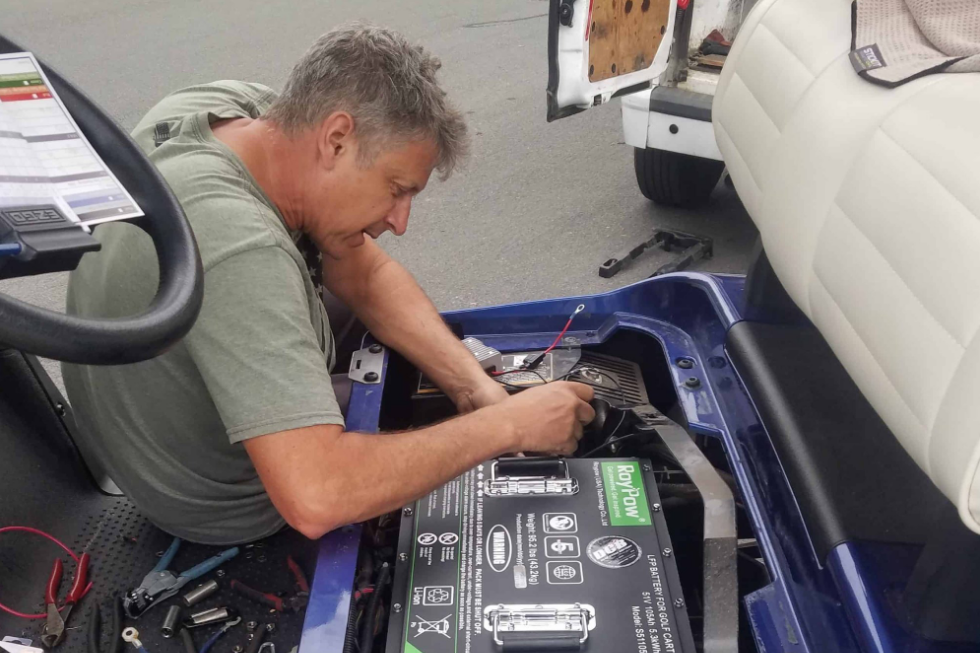
Image Source: www.indiamart.com
o Regular Inspection
Inspect lithium-ion batteries regularly. Look for signs of damage. Regular inspection helps to prevent sudden failures.
o Cleaning
Clean batteries to remove dust and dirt. A clean battery works better and lives longer.
o Connection Check
Check all battery connections. Loose connections can cause power loss.
o Discharge Rate
Monitor the discharge rate. If a battery discharges too quickly, it might need replacement.
o Overcharge Avoidance
Never overcharge a lithium-ion battery. Overcharging can reduce battery life and cause safety issues.
o Temperature Management
Maintain an optimal temperature. Too high or too low temperatures can harm the battery.
o Damage Check
Always check for physical damages. Even minor damage can lead to serious problems.
o Capacity Verification
Verify the battery’s capacity regularly. A declining capacity signals the need for a replacement.
o Cell Balancing
Ensure that all cells in a battery pack are balanced. Imbalanced cells can affect performance.
o Safe Storage
Store the batteries safely when not in use. Proper storage extends battery life and prevents safety hazards.
Real-world Applications of Lithium Ion Batteries!
o Electric Vehicles
Modern cars use lithium-ion batteries. For each battery, manufacturers mix lithium, cobalt, and oxygen to make the positive electrode. Then graphite and copper are combined for the negative one. Finally, the two electrodes get separated by a thin plastic sheet, and liquid electrolyte is added. Now the battery is ready to power electric cars.
o Energy Storage
In power stations, lithium-ion batteries store excess energy. In production, cathode materials of lithium, nickel, and manganese are mixed, heated, and grinded. Afterward, anodes of graphite are made. With precision, the parts get assembled. After testing, the batteries are ready to store power for future use.
o Portable Electronics
For portable devices like smartphones, small lithium-ion batteries are required. Tiny layers of lithium-cobalt oxide and graphite are made. They are inserted into a case with a separator and electrolyte. Once sealed, the batteries can provide hours of use on a single charge.
o Power Tools
In power tools, lithium-ion batteries offer long-lasting power. Battery manufacturing starts with preparing slurry. The slurry gets coated onto a copper foil, and after drying, it’s rolled up with a separator. Once in a case with an electrolyte, it’s ready to power tools for hours.
o Medical Devices
Medical devices rely on safe and reliable lithium-ion batteries. During the manufacturing process, lithium iron phosphate forms the cathode. Graphite serves as the anode. Carefully assembled, these batteries can then sustain life-saving medical devices.
o Aerospace Applications
Aerospace tech uses lithium-ion batteries for their lightweight and power density. For these high-spec batteries, a lithium cobalt oxide cathode pairs with a graphite anode. Encased and sealed with electrolyte, these batteries are ready to withstand the harsh environment of space.
o Military Equipment
Military gear uses durable lithium-ion batteries. In their production, lithium manganese oxide is used as the cathode. Graphite is used for the anode. Assembled with high precision, these batteries provide reliable power in even the most demanding military operations.
o Marine Vessels
On the sea, marine lithium batteries power many systems. In production, lithium nickel cobalt aluminum oxide forms the cathode. Carbon serves as the anode. Once assembled and tested, these batteries can deliver energy to marine vessels in all sea conditions.
Conclusion
Every stage of the lithium-ion battery manufacturing process brims with rigorous quality checks, expert skills, and state-of-the-art technology. Each stage, from raw materials to real-world application, unfolds with careful consideration. Encourage yourself to learn more at BuzzUP. Power the future. Discover the energy that drives modern life. Continue this exciting journey into the world of lithium-ion batteries.


